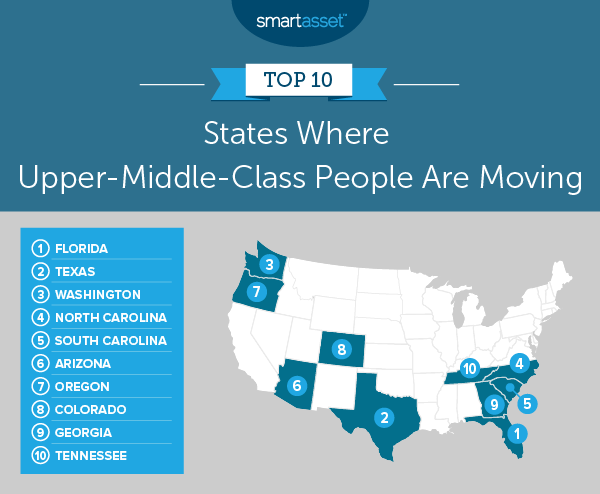Moving to a new home can be a difficult undertaking, even though it might bring your life a much-needed change, especially when you have significant financial costs to consider. As you look to make intelligent decision that can help boost the balance in your savings account, it’s important to do your research before you eliminate any possible locales. After all, trends might indicate that certain places are more popular for your demographic than you might think and thus conducive to your lifestyle. For instance, the rich and the retired aren’t the only groups moving to Florida. From 2015 to 2016, the Sunshine State actually saw a significant net inflow of 10,266 upper-middle-class people as well, which makes it the top destination for individuals with incomes between $75,000 and $100,000.
To figure out where else the upper middle class is moving, we examined two metrics: the inflow and outflow of upper-middle-class people in each state. We defined upper-middle-class people as individuals with incomes above $75,000 and below $100,000. For a more complete explanation of how we created our list, read the Data and Methodology section below.
Key Findings
- The upper middle class is headed down South and out West – Out of the top 10 states where upper-middle-class people are moving, six are in the South. The remaining four are in the West. It’s worth noting here that the top two states on our list, Florida and Texas, don’t have a state income tax.
- Upper-middle-class people are leaving the Northeast – Four of the five lowest-ranking states in our study are in the Northeast. These states have net outflows ranging from about 1,800 to about 6,800, and an average net outflow of approximately 3,267.

- Florida
Florida is a popular destination across many demographics. In addition to ranking as the top state where upper-middle-class people are moving, it also ranks as the top destination for the wealthy (individuals with an AGI of more than $100,000), Gen Xers and retirees. From 2015 to 2016, the Sunshine State had a net inflow of 10,266 upper-middle-class individuals.
- Texas
Though it ranks just one spot below Florida, Texas had less than one-third the Sunshine State’s net inflow of upper-middle-class people from 2015 to 2016. The Lone Star State had 20,340 upper-middle-class people move there in that timespan, while 17,277 upper-middle-class people left. This resulted in a net inflow of 3,060 upper-middle-class individuals.
- Washington
Washington State, which claims the third spot in our rankings, is the only state in the top five that is not in the South. From 2015 to 2016, the Pacific Northwestern state had a net inflow of 2,614 middle-class people. It’s also a popular destination for rich millennials as well as Gen Xers.
- North Carolina
North Carolina comes in fourth with a net inflow of 2,509 middle class people from 2015 to 2016. In total, 8,943 people with an annual income between $75,000 and $100,000 left the state, and 11,452 moved there. The Tar Heel State is also a popular destination for the wealthy, ranking as the state with the third-highest net inflow of rich people from 2015 to 2016.
- South Carolina
Another state in the South rounds out our top five. From 2015 to 2016, South Carolina saw a net inflow of 2,337 upper-middle-class individuals, with 6,480 upper-middle-class people moving there and 4,143 moving away. Like its northern counterpart, South Carolina is also popular with the wealthy. It saw a net inflow of 6,627 rich people in 2015 to 2016.
- Arizona
Arizona is the second state in the top 10 that’s not in the South. The state lost 6,630 upper-middle-class individuals from 2015 to 2016 but gained 8,696. This resulted in a net inflow of 2,066 individuals with an income between $75,000 and $100,000.
- Oregon
Though not quite as popular as Washington, the other Pacific Northwestern state in our top 10, Oregon has seen a substantial number of upper-middle-class individuals on their way in. From 2015 to 2016, the Beaver State had a net inflow of 1,874 individuals with incomes of more than $75,000 and less than $100,000. More specifically, 3,550 upper-middle-class individuals left the state and 5,424 made Oregon their new home.
- Colorado
Though not quite as popular among the upper middle class as it is among rich millennials, Colorado saw a substantial number of upper-middle-class individuals move in from 2015 to 2016. According to our data, 7,066 upper-middle-class people moved out of the state and 8,371 moved in. This resulted in a net inflow of 1,305 individuals with incomes between $75,000 and $100,000.
- Georgia
The ninth spot on our list, Georgia, is another representative from the South. Georgia boasted a net inflow of 1,067 upper-middle-class people from 2015 to 2016. Specifically, 8,421 individuals with incomes between $75,000 and $100,000 left the state, while 9,488 upper-middle-class people moved there.
- Tennessee
Tennessee rounds out our top 10 with a net inflow of 1,058 upper-middle-class individuals from 2015 to 2016. The Volunteer State said goodbye to 5,234 upper-middle-class residents in that time period. However, it welcomed 6,292 newcomers to the state.

Data and Methodology
To determine where upper-middle-class people are moving, we examined data across all 50 states, plus Washington, D.C. More specifically, we looked at the following two metrics:
- Inflow of upper-middle-class individuals: This is the number of individuals with an income above $75,000 and below $100,000 who moved into the state. Data comes from the IRS and is for 2015-2016.
- Outflow of upper-middle-class individuals: This is the number of individuals with an income above $75,000 and below $100,000 who moved out of the state. Data comes from the IRS and is for 2015-2016.
To create our rankings, we compared the inflow of upper-middle-class people to each state to the outflow of upper-middle-class people from each state. More specifically, we looked at the net inflow of upper-middle-class people (the inflow minus the outflow) to determine a state’s net gain of upper-middle-class people. We then ordered the states in descending order according to net inflow.
Tips for Buying a Home
- Figure out how much home you can realistically afford – Thinking about moving to a new state? Before you start shopping around for a home, it’s crucial to establish your price range. Though it’s important to get a home that you like, you shouldn’t sacrifice other financial goals, like saving for retirement, to do so. Experts typically recommend that you keep your total costs, which include property taxes and home maintenance, to below 30% of your net income. SmartAsset’s home affordability calculator can help you figure out how much is realistic for you to spend.
- Talk to an expert – Buying a home is a major investment and thus presents a good opportunity to get advice from a financial professional. A financial advisor can help you evaluate your overall financial situation and determine how buying a home will fit in with your other financial priorities. You can easily find a financial advisor who meets your needs with SmartAsset’s financial advisor matching tool. All you have to do is fill out a brief questionnaire, and we’ll match you with up to three advisors in your area. It’s up to you to decide which of your advisor matches best suits your needs.
Questions about our study? Contact us at press@smartasset.com
Photo credit: ©iStock.com/PeopleImages
